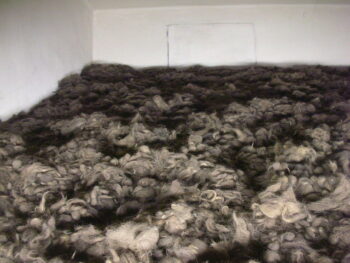Auschwitz Museum
Measured by yearly visitors, the Auschwitz Museum is the largest Holocaust-related Museum in the world, with a pre-COVID peak visitor number in 2019 of 2.3 million visitors.

Showcase at the Auschwitz Museum, showing a layer of long fibers deposited on an inclined plane giving the false impression of a huge pile. These fibers all have the same color, whereas human hair would come in various colors: black, brown, auburn, red, orange, copper, blond, grey, salt & pepper, white. Moreover, the Museum claims that this is hair shorn off the heads of inmates after having been murdered at Auschwitz. However, every inmate admitted to the camp had their hair shorn. (See the illustrations in the entry on the Auschwitz Album.) If exceeding a certain length, this hair was collected, disinfested, bagged and submitted to companies for commercial use. No evidence exists whatsoever that this a) is human hair (it may just be flax), b) originates from murdered people.
The Auschwitz Camp Museum is also Poland’s most-important foreign-policy asset, something that keeps the Jewish lobby happy and the Germans in a psychological stranglehold.
The main exhibit area of the Auschwitz Museum consists of the almost completely preserved Main Camp. The Birkenau Camp has very few original structures remaining. The ruins of the four crematoria are presented more as symbols than as education about anything, least of all real cremation technology.
The so-called Zentralsauna, Birkenau’s main shower and disinfestation facility, though largely intact, is not used to enlighten visitors much about the diverse and strenuous efforts of the German camp administration to improve the camp’s healthcare services, sanitation facilities and hygienic conditions. This would evidently distract too much from the gas-chamber and cremation-furnace horror show that is the camp’s main attraction.
The Museum’s most-prized asset is no doubt the “reconstructed” – but actually phony – old crematorium. It has the ill-boding furnace room equipped with two – badly – reconstructed double-muffle furnaces, and the alleged homicidal gas chamber with four ominous Zyklon-B introduction openings in the ceiling/roof. That they were mendaciously inserted only in 1947, hence after the war, with no proven relation to any original, is hushed up. (For more on this building, see the subsection “Crematorium I” of the “Propaganda” section in the entry on the Auschwitz Main Camp.)
Another attraction is the basement area of Block 11, the so-called detention bunker. In its cells, the infamous “first gassing” with Zyklon B is said to have unfolded. No one explains to the million tourists that this entire event was invented from scratch. (For details, see the entry on the “first gassing, at Auschwitz.”)
Other assets include showcases with what is presented as a pile of old shoes from murdered inmates. However, it is actually only a single layer of shoes of unknown origin fixed to an inclined plane. (For more on this show case, see the entry on shoes of deportees.) Piles of human hair, of spectacles, of luggage and other items that inmates may have brought along round off this collection of a German wartime camp’s efforts to store, preserve and perhaps recycle its inmates’ property. The Museum presents all this as evidence of mass murder. The average visitor is both spooked and impressed by these exhibits, although a pile of objects proves nothing about the fate of their former owners. This is as true for today’s used-clothes collection drives as it is for the Auschwitz Camp. (For more information, see the entries on hair of camp inmates, on gold teeth, and on wedding rings.)
Finally, Auschwitz has its bloody Black Wall, where thousands upon thousands of inmates are said to have been executed by shootings. As both wartime camp documents and British radio intercepts show, numerical claims in this regard are highly exaggerated as well. While executions did take place, they occurred as random events to the inmates, who had no insight into who had decided when to execute whom for what reason.
While death penalties during World War II were quite common among all belligerent parties, this does not mean that the Third Reich’s executions were legal, legitimate, just or wise. In fact, due to a persistent lack of any due process within the SS camp system, not even most incarceration could be considered legal, let alone death penalties.
(Next to the other entries mentioned, see esp. Mattogno 2020, pp. 7-38.)

You need to be a registered user, logged into your account, and your comment must comply with our Acceptable Use Policy, for your comment to get published. (Click here to log in or register.)